Do you remember this?
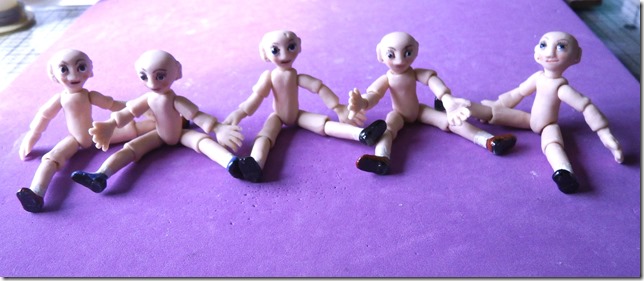
These are a few of the dolls that got as far as the porcelain last show, which I intend to offer as dolls’ dolls, dolls of the past and dolls from history.
I’m beginning here with a version of the French Fashion dolls which were so collectable in their heyday and continued to reprise their success right up to the 1960s when I recall them on various television programmes at quite startling prices for what had been toys for children.
On programmes like Going For A Song, on the BBC, experts such as Arthur Negus gave opinions and valuations of assorted antiques. Programmes like these were required viewing in our house, my father having been a life-long collector of antiquities, furniture, pictures, ornaments and so on. He was a builder. In the school summer holidays I used to accompany him to the latest building site and get in the way of the brickies and help the carpenters. We never went directly home. Even when tea time was looming perilously close we invariably returned via one or more antique shops. The car would be bowling along nicely when my father would suddenly pull in and park, announcing ‘Q shop.’ I would follow him into the shop and while he was doing the deals I would examine the stock, crawl under eighteenth century tables and look at hand sawn veneers, memorise pictures, and stare at elaborate china group figurines. I had no idea I was getting an education until dolls house miniatures came along and I spotted factual errors in magazines for miniaturists trying to replicate history in miniature. Writers who had only book learning copied mistakes in books, a state of affairs which sadly persists.
In one antique shop near Hexham there was a singing bird in a cage which I loved. At the end of the visit the shopkeeper would make the bird sing for me. I always asked to buy it and was laughed at because the beautiful automaton cost £100, an unthinkable amount for an ordinary family in the late 1950s and impossible for a child with sixpence a week pocket money.
Skip forward nearly a decade and there was the singing bird, introducing Going For A Song. My father was very good at the valuations. This was hardly surprising from such a red-hot collector. I got good at them too and noted how often beautiful nineteenth century dolls commanded extraordinary valuations. Arthur Negus continued for many years to be the TV expert on antiques, especially furniture. My father continued to learn too. When Arthur died suddenly in 1985 he had been due to give a talk. My father was invited to give the talk in his stead. By this time he had opened an antique shop and picture gallery in Cheltenham as a retirement business. Just a couple of years later I fell down the miniature rabbit hole, finding, when I landed, that I had arrived with a wealth of knowledge about what should and should not be in a miniature house of any era. I continued to learn, chasing the same knowledge back for a thousand years. After a few years, in reality, not needing to build the house anywhere but in my head.
Meanwhile I had discovered that all things miniature in houses were accurate tiny versions of full sized antiques, all except the dolls.
At the end of the Sixties the desire to reproduce beautiful antique dolls that could be sold for substantial sums of money when the actual antiques had all gone to live with collectors, coincided with and stimulated the development of, small kilns that would run off a domestic electricity supply. As various businesses in America jumped on the band waggon, kilns and all the supplies necessary to make the dolls were exported all over the world. Here in the UK we had already had many firms making porcelain items since the eighteenth century. By the time I was interested in buying a kiln in the early eighties there were quite a few places to visit in and around the potteries in Stoke on Trent.
The American model of doll making was a sort of pyramid structure in which the aspiring doll maker could buy bottles of clay slip and moulds to pour the clay slip into, china paints, wig caps and all necessities. Signed up for classes and starting by using the teacher’s kiln, the doll maker worked away until the day, months or years later when they could reproduce an antique porcelain doll. The first moulds for reproduction were made from disassembled antique dolls. I was told early in my interest that it was not possible for any ordinary mortal to make the original dolls from which to take moulds. I was aware that one or two commercially available moulds had been made from ‘tweaked’ originals. There were doll makers in the UK making dolls as a cottage industry, receiving supplies of dolls at every stage of manufacture and finishing and returning completed dolls for sale at fairs and by mail order. A number of the nineteenth century factories they were copying had evolved in exactly that way.
The collectable porcelain dolls flourished from about a quarter of the way through the nineteenth century to the turn into the twentieth but the first and second world wars effectively killed them off because they were mainly produced in Germany and France.
Many parts of Germany have been toy producing areas of note since the middle ages. In the beginnings of the industry, components were produced at varying locations and brought elsewhere to be assembled. Doll heads were often made of different materials to bodies, which could be quite crudely modelled jointed wood or sewn cloth. The heads could be of papier mâché or composition, which could be almost anything mixed with plaster which would harden into a shape when pressed into a mould. No one knows which toymaker first thought of asking a china factory to make dolls heads. There is a legend that the incredibly famous Meissen factory made dolls’ heads for a while, though no known examples survive. London was one of the cities involved in assembly of components and doll dressing, as it had been since wooden dolls were sold at Bartholomew fair in Tudor times.
German porcelain heads were exported to France to have French bodies fitted and elaborate costumes added. Expertise grew in adding glass eyes, real hair wigs and dolls which could walk, talk or move. Porcelain bisque, which is to say, unglazed china, heads simulated skin more closely than glazed white china had previously done.
In doing a bit of reading up, to decide what kind of French Fashion doll to attempt, I picked up my Collins Gem doll book and found an error. It describes heads needing special supports in the kiln to provide for the weight of any water still in the clay distorting the fired result. This of course is incorrect. If you put a wet head in the kiln it would explode and damage everything else in the vicinity. In fact whether made from sheets of hard clay, soaked and pressed into moulds or from liquid clay poured in and out to make a casting, no porcelain doll head would be put in a kiln for first firing until it was dry. Writers who have never fired a kiln assume the kiln drives off water in the clay. It does not. It drives off the jacket of air round each molecule of clay, shrinking the clay body, so that the shape emerging from the mould will be about 12% smaller than the clay that was put in.
This, interestingly, is why the porcelain dolls made from disassembled antique doll parts would never be the same as the originals, they would always be smaller.
By the mid century the commercial success of the beautiful dolls made in Germany and France was sufficient to justify the foundation of factories in both countries making every part of the doll in every type of material. Competition between manufacturers drove the innovations; in the third quarter of the century some of the works of art produced were so great they immediately found their way to collectors and it is at this juncture that automatons of various sorts, including singing birds in cages, dolls playing pianos and rabbits rising from cabbages appeared in quantity.
I have made my doll to be from around this juncture of the history of these collectors’ dolls.
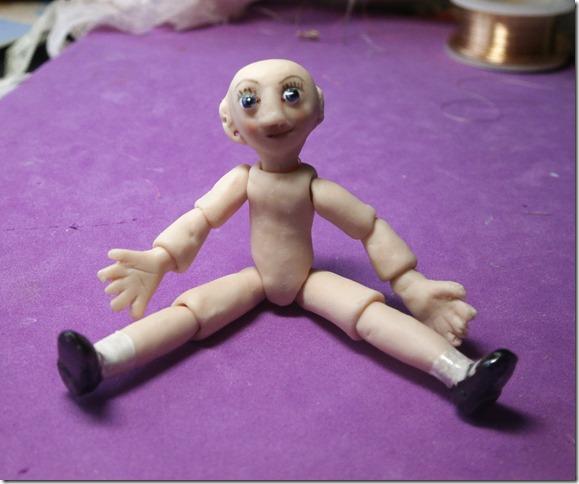
I have given her all the joints a mid century doll would have, except that the originals, if mass produced for children, would be more likely to have cheaper composition or gusseted cloth bodies. The head is on a neck socket joint. This type of head with the neck as part of the head shape developed from the earlier white china shoulder head dolls, which persisted into late Victorian dolls’ house dolls. When I began, this was the only type of commercial doll mould available. I decided a joint at the base of the skull, as in you and me, gave a much better movement and modelled all my originals this way. Returning to this older way of jointing, which was the preferred mid century joint at the Jumeau factory has been a pain in the neck to say the least. I can only do it now because of the development of resin jewellery elastic and my familiarity with it for stringing my 24th scale dolls. I have also followed my own type of elbow and knee joints. The composition moulded originals have ball and socket joints which work well but do not look pretty.
One thing all the Victorian dolls have in common is elaborate dressing with acres of lace and fancy hats.
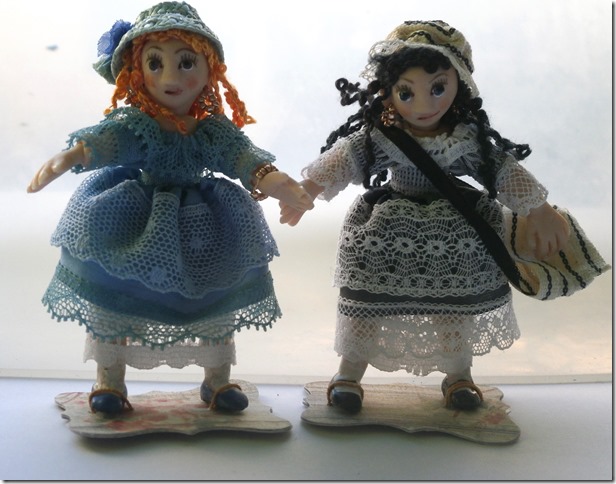
Like this. There are five dolls in themed colours, which is also as the originals were.
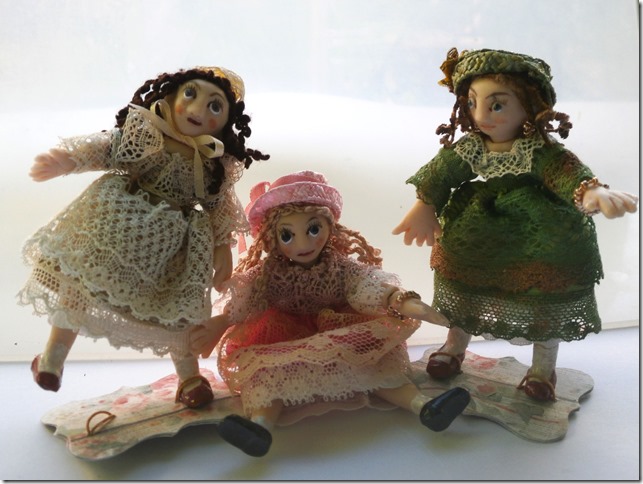
They all seem fairly cheerful and, as you can see, the joints give a range of movement. If you want to put them in a Victorian toy shop they can stand on their stand in the window, or they could sit on the bed in your Victorian nursery, or in the glass case of your miniature museum.
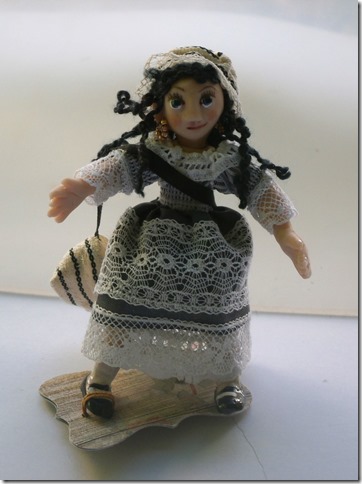
At just a whisker over three inches tall, they could be residents if you were wanting to make a one sixteenth old style house or oversized twenty-fourth, they could also be twelfth scale children.
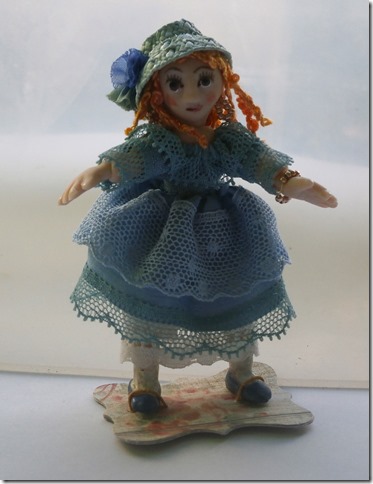
They have pierced ears, earrings, bracelets and hats. Needless to say, if you are a big doll collector looking for a doll for your doll…
I may in the future shrink these. I did intend these just to be for shrinking initially because I couldn’t really predict how well the socket head would work with the resin elastic. As it was, though I poured plenty, only five got through all the processes and I couldn’t bear to use one in bits to make moulds from. I might pour some more after the Min to shrink in the future.
Meanwhile I have older type white china heads, ancient Greek dolls, seventeenth century dolls and, after years of requests, Tudor dolls’ dolls, which may, with a bit of luck, turn out to be doll kits, to be getting on with.
The history of dolls is as old as little girls.
And big girls and collectors who have not abandoned their childhood friends.
~~~~~~~~~~~~~~~~~~~~~













